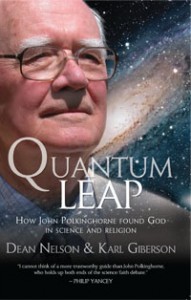BOOK REVIEW: Connecting God and science
December 25, 2011 8:00 am • By KENT DAVY [email protected]
Link to article on nctimes.com>
Particle physicist and cleric aren’t typically labels affixed to the same man. The two disciplines, in the minds of many, point to mutually exclusive points of view: one sees knowledge as the product of scientific experimentation, the other looks outside the material, rational world to find truth.
Theoretical physicist turned cleric John Polkinghorne does both.

“Religious belief isn’t shutting your eyes, gritting your teeth, believing six impossible things before breakfast because the Bible tells you that’s what you must do,” Polkinghorne said at a 1999 debate with friend, fellow scientist and atheist Steven Weinberg, “It is a search for a motivated belief —- a difficult search and different people will reach different conclusions about it. But you don’t have to commit intellectual suicide to be a religious believer; otherwise I wouldn’t be one.”
In their tapestry of the life of the Cambridge-educated Polkinghorne, titled “Quantum Leap” (Monarch Books, ), authors Dean Nelson and Karl Giberson weave biography and theology to reveal a man whose scientific work helped establish the existence of the quark and whose faith pushed him to service as an Anglican priest. And the work shows the way to a curious comfort in the uncertainty of both points of view.
Nelson is dean of the journalism department at Point Loma Nazarene University and a prolific author of books, magazine articles and newspaper reports (including the North County Times). Giberson directs the science and religion writing workshop at Gordon College in Wenham, Mass.
The team, which conducted extensive interviews with Polkinghorne, has written an accessible account that offers an understanding of the humble philosophy that allowed the scientist to become priest without abandoning either kind of truth.
In 1979, Polkinghorne astounded his graduate students and fellows by announcing that he would step away from his academic post to join the priesthood.
As Nelson and Giberson relate this remarkable journey, they come to and then explore the money question: “But in an age where science seems to increasingly answer many of life’s big questions, one can justifiably ask why would Polkinghorne —- or anyone else, for that matter —- believe in God at all?”
They offer three reasons from Polkinghorne:
First, that belief in God is rational, not delusional —- despite that fact that believers might be mistaken.
Second, that science and religion are compatible. Each require faith and each have unanswered questions.
Third, that the universe is not mere machinery. “In particular, science does not require us to believe that we do not have free will” and that the future is not “the inevitable consequence of the past.”
As explained here, Polkinghorne’s view is founded on the work of Hungarian polymath Michael Polanyi, and allows that both science and religion are ways to understand ultimate reality.
“In that picture,” Polkinghorne has written, “Science and theology, reason and revelation, all find their place.”
Another theme connects the Polkinghorne book to Nelson’s previous book, “God Hides in Plain Sight” (Brazos Press, 2009) in which Nelson uses the seven Christian sacraments as a lens to explore God’s participation in this life.
In the chapter “Reaching Match Point” of the latter book, Nelson recounts the journey of a dying friend, who writes in answer to Nelson’s inquiries: “The surgery was not successful. The tumor I still have with me. … God doesn’t always give us what we want. But he does hear. We bet our lives on that …”
Nelson writes then of seeing the grace in dying with denying the inevitable grief and loss.
That parallels an experience recounted by Polkinghorne in the new book, who lost his wife to a lengthy struggle with cancer shortly after the couple’s 51st wedding anniversary.
Nelson and Giberson quote Polkinghorne: “It was the transformation of suffering —- both awful and glorious. I was sorry she didn’t stay longer. I don’t think that if we had more faith she would have been healed. She didn’t think that, either. … Her healing was in our acceptance and being present with her.”
With “Quantum Leap,” the authors open doorways for the reader to engage in a real and sophisticated thought on meaningful life-and-death topics.
And they allow us to ask the most important question of all: God, are you there?